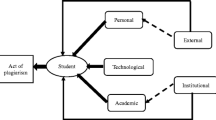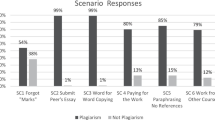Abstract
Scholarship on faculty and student perceptions of plagiarism is plagued by a vast, scattered constellation of perspectives, context, and nuance. Cultural, disciplinary, and institutional subtitles, among others in how plagiarism is defined and perspectives about it tested obfuscate consensus about how students and faculty perceive and understand plagiarism and what can or should be done about those perspectives. However, there is clear consensus that understanding how students and faculty perceive plagiarism is foundational to mitigating and preventing plagiarism. This study takes up the challenge of investigating its own institution’s student and faculty perspectives on plagiarism by testing whether students and instructors differentiate between different kinds or genres of plagiarism, and measuring differences in their perception of seriousness or severity of those genres. Using a device modified from the ‘plagiarism spectrum’ published by Turnitin®, the researchers implemented a campus-wide survey of faculty and student perceptions, and analyzed the data using two different methodologies to ensure results triangulation. This study demonstrates both students and faculty clearly differentiate between kinds of plagiarism, but not on their severity. This study demonstrates both students and faculty clearly differentiate the severity between kinds of plagiarism, but not on the specific rank or order of their severity. Further, this study’s novel methodology is demonstrated as valuable for use by other academic institutions to investigate and understand their cultures of plagiarism.










Similar content being viewed by others
Notes
iParadigm’s The plagiarism spectrum: Instructor insights into the 10 types of plagiarism (2012) claims to have utilized, “both higher and secondary education instructors to take a measure of how prevalent and problematic these [examples] of plagiarism are among their students” (p. 9) in their rankings. However, no further descriptions or details of the study’s population and sample, data collection methods, datasets, or analysis methods are provided.
References
Amiri, F., & Razmjoo, S. A. (2016). On Iranian EFL undergraduate students’ perceptions of plagiarism. Journal of Academic Ethics, 14(2), 115–131.
Bouville, M. (2008) Plagiarism: Words and Ideas. Science and Engineering Ethics, 14(3), 311-322.
Brimble, M., & Stevenson-Clarke, P. (2005). Perceptions of the prevalence and seriousness of academic dishonesty in Australian universities. The Australian Educational Researcher, 32(3), 19–44.
Camara, S. K., Eng-Ziskin, S., Wimberley, L., Dabbour, K. S., & Lee, C. M. (2017). Predicting students’ intention to plagiarize: An ethical theoretical framework. Journal of Academic Ethics, 15(1), 43–58.
Cheema, Z. A., Mahmood, S. T., Mahmood, A., & Shah, M. A. (2011). Conceptual awareness of research scholars about plagiarism at higher education level: Intellectual property right and patent. International Journal of Academic Research, 3(1), 666-671.
Childers, D., & Bruton, S. (2016). “Should it be considered plagiarism?” student perceptions of complex citation issues. Journal of Academic Ethics, 14(1), 1–17.
Curtis, G. J., Cowcher, E., Greene, B. R., Rundle, K., Paull, M., & Davis, M. C. (2018). Self-control, injunctive norms, and descriptive norms predict engagement in plagiarism in a theory of planned behavior model. Journal of Academic Ethics, (16), 1–15.
Drew, C. J., Hardman, M. L., & Hosp, J. L. (2007). Designing and conducting research in education. Thousand Oaks: Sage.
ERAU. (2017). ERAU Worldwide Student Handbook 2018=2019. [pamphlet]. Daytona Beach: ERAU.
Eret, E., & Ok, A. (2014). Internet plagiarism in higher education: Tendencies, triggering factors, and reasons among teacher candidates. Assessment & Evaluation in Higher Education, 8(39), 1002-1016.
Evans, G. W. (2016). Multiple criteria decision analysis for industrial engineering: Methodology and applications. Boca Raton: CRC Press.
Gullifer, J., & Tyson, G. A. (2010). Exploring university students' perceptions of plagiarism: A focus group study. Studies in Higher Education, 35(4), 463–481.
Hamlin, A., Barky, C., Powell, G., & Frost, J. (2013). A comparison of university efforts to contain academic dishonesty. Journal of Legal, Ethical and Regulatory Issues, 16(1), 35–46.
Hayes, N., & Intron, L. D. (2005). Cultural values, plagiarism, and fairness: When plagiarism pets in the way of learning. Ethics & Behavior, 15(3), 213–231.
Heckler, N. C., & Forde, D. R. (2015). The role of cultural values in plagiarism in higher education. Journal of Academic Ethics, 13(1), 61–75.
Heiman, G. W. (2006). Basic statistics for the behavioral sciences (5th ed.). Boston: Houghton Mifflin.
Howard, R. M. (1992). Plagiarism and the postmodern professor. Journal of Teaching Writing, 11(2), 233–245.
Howard, R. M. (2007). Understanding “internet plagiarism”. Computers and Composition, 24(1), 3–15.
Hu, G., & Lei, J. (2015). Chinese university students’ perceptions of plagiarism. Ethics & Behavior, 25(3), 233–255.
iParadigms, LLC. (2012). The plagiarism spectrum: Instructor insights into the 10 types of plagiarism (version 0512). Turnitin. www.turnitin.com
Ison, D. (2017). Academic misconduct and the Internet. In D. Velliaris (Ed.), Handbook of Research on Academic Misconduct in Higher Education (pp. 82-111). Hershey, PA.
Ison, D. C. (2012). Plagiarism among dissertations: Prevalence at online institutions. Journal of Academic Ethics, 10(3), 227–236.
Josien, L., & Broderick, B. (2013). Cheating in higher education: The case of multi-methods cheaters. Academy of Educational Leadership Journal, 17(3), 93–105.
Khoshsaligheh, M., Mehdizadkhani, M., & Keyvan, S. (2017). Severity of types of violations of research ethics: Perception of Iranian Master’s students of translation. Journal of Academic Ethics, 15(2), 125–140.
Löfström, E., & Kupila, P. (2013). The instructional challenges of student plagiarism. Journal of Academic Ethics, 11(3), 231–242.
Löfström, E., Huotari, E., & Kupila, P. (2017). Conceptions of plagiarism and problems in academic writing in a changing landscape of external regulation. Journal of Academic Ethics, 15(3), 277–292.
Logie, J. (2005). Cut and paste: Remixing composition pedagogy for online workspaces. In K. St. Amant, & P. Zemliansky (Eds.), Internet-Based Workplace Communications: Industry and Academic Applications (pp. 299-316). IGI Global.
Louw, H. (2017). Defining plagiarism: Student and staff perceptions of a grey concept. South African Journal of Higher Education, 31(5), 116–135.
McDonald, J.H. (2014). Handbook of biological statistics (3rd ed.). Baltimore, MD: Sparky House Pub.
Ramzan, M., Munir, M. A., Siddique, N., et al. (2012). Awareness about plagiarism amongst university students in Pakistan. Higher Education, 64, 73.
Razera, D., Verhagen, H., Pargman, T. C., & Ramberg, R. (2010, June). Plagiarism awareness, perception, and attitudes among students and teachers in Swedish higher education—A case study. In 4th International plagiarism conference–towards an authentic future. Northumbria University in Newcastle Upon Tyne-UK (pp. 21-23).
Reyman, J. (2008). Rethinking plagiarism for technical communication. Technical Communication, 55(1), 61–67.
Rezanejad, A., & Rezaei, S. (2013). Academic dishonesty at universities: The case of plagiarism among Iranian language students. Journal of Academic Ethics, 11(4), 275–295.
Saaty, T. L. (1978). Modeling unstructured decision problems—The theory of analytical hierarchies. Mathematics and Computers in Simulation, 20(3), 147–158.
Sutherland-Smith, W. (2005). Pandora's box: Academic perceptions of student plagiarism in writing. Journal of English for Academic Purposes, 4(1), 83–95.
Sutherland-Smith, W. (2014). Legality, quality assurance and learning: Competing discourses of plagiarism management in higher education. Journal of Higher Education Policy and Management, 36(1), 29–42.
Turnitin, LLC. (2017). Plagiarism.org. Retrieved from https://www.plagiarism.org/
Vie, S. (2013). A pedagogy of resistance toward plagiarism detection technologies. Computers and Composition, 30(1), 3–15.
Walker, J. (2010). Measuring plagiarism: Researching what students do, not what they say they do. Studies in Higher Education, 35(1), 41–59.
Watson, G., Sottile, J., & Liang, J. G. (2014). What is cheating? Student and faculty perception of what they believe is academically dishonest behavior. Journal of Research in Education, 24(1), 120–134.
Wilkinson, J. (2009). Staff and student perceptions of plagiarism and cheating. International Journal of Teaching and Learning in Higher Education, 20(2), 98–105.
Yeo, S. (2007). First-year university science and engineering students’ understanding of plagiarism. Higher Education Research & Development, 26(2), 199–216.
Author information
Authors and Affiliations
Corresponding author
Additional information
Publisher’s Note
Springer Nature remains neutral with regard to jurisdictional claims in published maps and institutional affiliations.
Appendix
Appendix
Survey Instrument



Rights and permissions
About this article
Cite this article
Denney, V., Dixon, Z., Gupta, A. et al. Exploring the Perceived Spectrum of Plagiarism: a Case Study of Online Learning. J Acad Ethics 19, 187–210 (2021). https://doi.org/10.1007/s10805-020-09364-3
Published:
Issue Date:
DOI: https://doi.org/10.1007/s10805-020-09364-3




